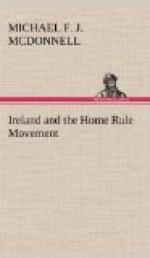With regard to ecclesiasticism in the lower branches of education, while convinced that popular control over the secular branches, leaving the religious branches of such education completely in the hands of the clergy, is the ideal arrangement, one must admit that there is a striking testimony contained in the Report on Primary Education drawn up in 1904 by Mr. F.H. Dale, as to the efficiency and good management of the Convent Schools in Ireland, which, it should be noted, are at the same time those of least expense to the State. The cleanliness and neatness of the premises, the supervision and management on the part of the Community, the order and tone of the children, are all highly praised; and in a further Report on Intermediate Education, prepared by the same Inspector of Schools jointly with a colleague, will be found equally strong insistence on the well-known success and efficiency of the three hundred schools of the Christian Brothers, in which, without a penny of State aid, are educated some 30,000 pupils; and it was no doubt to the education given by the Christian Brothers that the Protestant Bishop of Killaloe referred when, in an address to his diocesan synod five years ago, he generously recognised the superiority of the Catholic over the Protestant schools in Ireland.
It was Lord Lytton, I think, who described the Established Church in Ireland as the greatest bull in the language, since it was so called because it was a church not for the Irish. All who are acquainted with those masterpieces of Swift’s satire—the Drapier Letters—and who appreciate the fact that Berkeley—the most distinguished of Irish Protestant bishops—was refused the Primacy of Ireland because he was an Irishman, and that to appoint any but an Englishman or a Scotsman would be to depart from the policy followed throughout the whole of the eighteenth century, will see that at that time, at any rate, it deserved the censure which it has received as a foreign body maintained for denationalising purposes.




